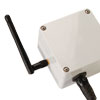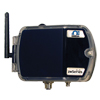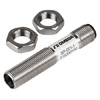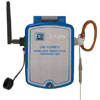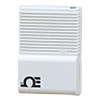A Wireless Temperature Monitoring system delivers Great Benefits for Temperature Monitoring
Temperature is certainly among the most commonly measured parameters in industry, science, and academia. Recently, the growth of wireless instrumentation technology, along with some clever innovations, has provided new ways to apply temperature measurement sensors combined with personal computers to collect, tabulate, and analyse the data obtained. For complex, multi-sensor applications, a Wireless Temperature Monitoring system provides a means to eliminate the nuisance of running multiple leads over long distances through harnesses or conduit to a control room, instrument panel, or equipment rack, while keeping track of which leads are which. For simpler one or two sensor applications, it means installing the wireless sensor, setting up the receiver, and being done.
There are now so many wireless transmitting and receiving devices available for temperature measurement that nearly any application can benefit from their use. In any case, it is certainly worth a closer look. As a bonus, most of the devices shown also work with humidity and barometric pressure sensors.
Transmitter Options
The temperature sensors most commonly in use are thermocouples and Pt100 RTDs (100 ohm platinum resistance temperature detectors). The various types of transmitting units available will handle nearly any type or model, and, depending on obstructions and other factors that affect transmission, can have ranges of up to 120 metres, so there are not many applications that cannot be addressed.
The simplest transmitting devices, like the wireless thermocouple connectors shown on the left, the
MWTC and
UWTC (Patented by Omega Engineering, Stamford, CT), accept a plug-in sensor and transmit the data to a receiving device at programmable intervals of 5 seconds to 1 minute. Depending on this sampling rate, battery life can be a year or more. In addition to temperature readings, these units transmit battery status information which help ensure timely battery replacement and prevent unexpected sensor-down situations.
For outdoor applications or harsh environmental conditions, a wireless IP or NEMA rated transmitter, shown on the left, the
UWTC-NEMA Enclosure can be used. These devices transmit the same data as those in standard enclosures, but have a much longer battery life (up to 3 years), since they may be installed in remote or difficult to access locations. A weather seal protects the internal sensor connections.
The Omega Z-Series feature attractive wall mount, battery powered transmitters with built in sensors. Models are available for Temperature, Humidity and Barometric Pressure. High power, IP rated industrial transmitters are also available.
The RS232 interface has been popular in the past for sensors with built-in electronics. However, RS232 cable lengths are limited to 15 metres. For longer runs,wireless RS232 transmitter/receiver sets like the one shown on the left, the
WRS232-USB RS232 are available. The RS232 output is forwarded to the receiver, which converts it to USB protocol for connection to a PC. The PC can still communicate with the RS232 device as if it is directly connected. This type of Wireless Temperature Monitoring system is suitable for both new installations and retrofits.
When making measurements in liquids or corrosive environments, the thermocouple or RTD sensing device often needs to be protected. In such cases, a probe, which encloses the sensing device in a protective tube or shell, is commonly used. For these applications, a wireless sensor probe transceiver, such as
UWTC-NB9, integrates the wireless transmitter with the probe in a single unit.
Receivers Get Sophisticated
As useful as the wireless transmission options for temperature sensors may be, they represent only half of the story. It is the innovation in receivers that brings new capabilities for measurement and process control.
The most common receivers connect to a PC through a USB port. An example is the 48-channel wireless USB receiver
UWTC-REC1. The accompanying software displays the readings from each channel, as well as the sensor type, sensor designator or description, ambient temperature, units, signal strength and battery condition. High and low temperature alarms are indicated by a blinking red reading. Data can be saved to a file for purposes of charting and analysis. A typical channel display as shown in Figure 1 (Omega Engineering, TC Central Software).
For those cases in which an analogue signal is necessary to provide process feedback to a controller or PLC, receivers that include an analogue output for one channel are available. A display can be added to show this reading on the unit, although it will also be displayed on the computer screen.
The most interesting new receivers do not require a host computer at all. They are built with embedded web servers and connect directly to an Ethernet network or to the Internet with a standard RJ45 plug. Such a device has its own IP address and serves active web pages which display real time temperature readings and charts. It is accessed for viewing and configuration using a PC with a web browser. Access can be restricted through password protection. Additional capabilities typically include alarm notification by email or even text messaging.
Web-based wireless receivers allow ad hoc monitoring using a pc from any location having an Internet connection. In addition to allowing data to be viewed from more than one location, this effectively removes any restriction on the distance of the monitoring point or control centre from the temperature sensors being monitored. A typical web-based receiver is the
UWTC-REC3, this particular unit handles up to 32 channels.
What about the situation in which remote monitoring is desirable, but the machine or process operator needs access to the readings locally? A wireless panel meter, like our
wi Series is ideal and does just that. This web-based receiver is also a wireless scanner that displays the output from up to 8 sensors. It adds local machine or process control capability by means of relay contacts and voltage output signals.
Typical browser screens from a web-based wireless receiver are shown in Figure 2. The top screen shows sensor readings, and the bottom screen shows a chart of data that has been logged. The screens are interactive and allow configuration programming of the receiver.
Conclusion
As this brief introduction of wireless transmitters and receivers for temperature measurement shows, many of the old limitations and complexities of point-to-point, mechanically interconnected instrumentation systems no longer apply. The engineer, technician or scientist can use these new devices to gain a freedom and flexibility in system design and installation that was not previously available. Control can be centralised or decentralised and data can be collected and analysed in real time or later using readily available personal computers.
Although we are enmeshed in a web of wired devices, we seldom notice it, but just take a look at the typical telephone pole on your way home or behind your computer when you get there. Fortunately, for those involved with instrumentation, the explosive growth of Wireless Temperature Monitoring systems in communication, measurement and control offers a promise of escape from at least some of the entanglement in this "tyranny of wires" that we face in our day-to-day work.
 CLOSE
CLOSE

